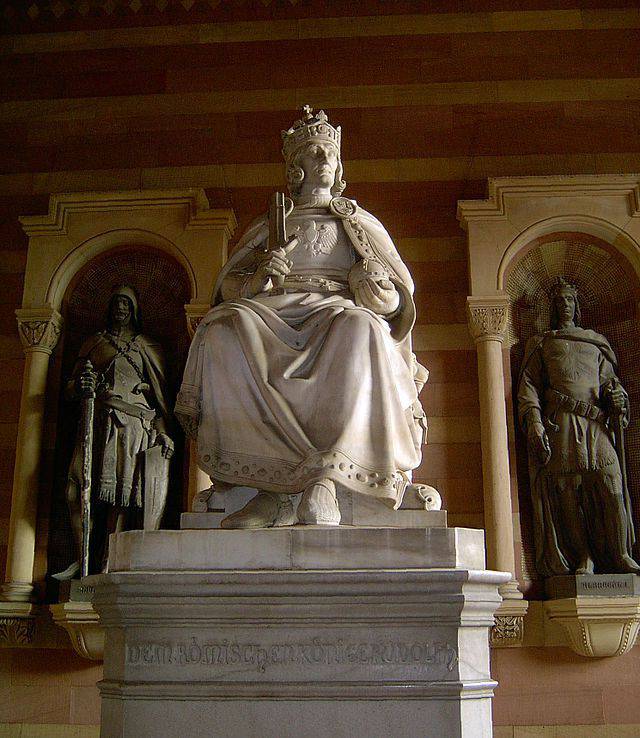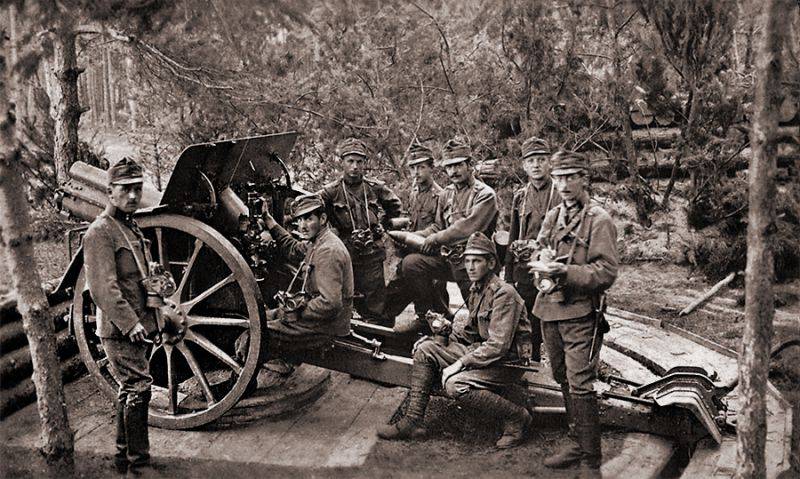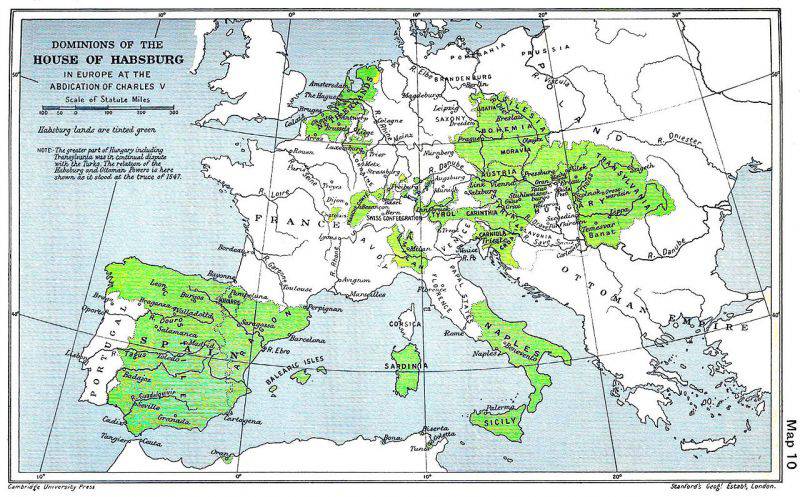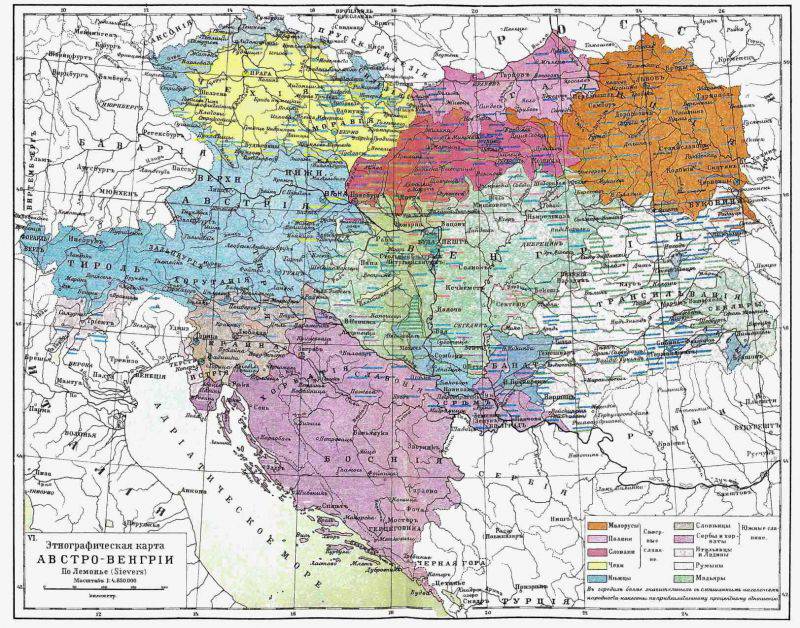Austria-Hungary in the First World War
In the First World War, the Austro-Hungarian Empire was Germany’s main ally. Formally, the all-European war began two countries - Austria-Hungary and Serbia. The conflict between Austria-Hungary and Serbia over the assassination of Austrian Archduke Franz Ferdinand and his wife in Sarajevo, organized by the Serbian nationalist organization Black Hand, caused a chain reaction and led to a world war.
Austria-Hungary was a convenient target for such a provocation. Too tight a knot of geopolitical, national and socio-economic contradictions was tied up in this empire so that it was not used by external forces interested in starting a pan-European war.
Habsburg
By the beginning of the 20th century, the Austro-Hungarian Empire was one of the great European powers, the second largest by area and the third largest European country. The origins of the Habsburg dynasty are rooted in the early Middle Ages. The founder of the dynasty is Guntram the Rich, who lived in the middle of the X century. At the end of the 10th century, the Habsburgs appeared in Switzerland and gradually expanded their possessions, becoming the largest landowners of northern Switzerland and earls, becoming a noble family who were destined to become one of the most famous ruling dynasties stories Europe.
At first, the Habsburgs were, though rather rich and strong, but still second-class in imperial scale, a family. They did not belong to a select circle of imperial elector princes, had no links with the ruling houses of Europe, their land was not a separate principality, but a set of lands scattered in Switzerland and south-west Germany. However, with each generation the social status of the Habsburgs grew, their possessions and wealth increased. The Hapsburgs were pursuing a long-term mating strategy, which became their "chip". Subsequently, it was marked by the slogan: "Let others fight, you, happy Austria, enter into marriages." However, if necessary, the Habsburgs were also able to fight. After all, they won the sword of Austria.
The reign of Rudolph I (1218 — 1291) marked the beginning of the Hapsburg rise to European leadership. The marriage with Gertrude Hohenberg, the former heiress of a vast county in central Swabia, made Rudolph I one of the greatest rulers of southwestern Germany. Rudolph helped the emperor of the holy Roman Empire Frederick II and his son Conrad IV, which further expanded his tenure in Swabia. After the termination of the Hohenstaufen dynasty on the imperial throne, a period of interregnum and war began in Germany, which allowed the Habsburgs to expand their tenure even more. After the death of the last count of Kiburg in 1264, the castle and the possessions of the counts passed to Rudolf I Hapsburg, as his father Albrecht IV entered into a favorable marriage with a representative of the Cyborg family - the most influential heir to the Habsburg family in then-Switzerland and Rudolph became the full heir to the rich kind of. As a result, the Habsburgs became the most influential genus in Swabia.
After the death of German King Richard of Cornish in 1272, the imperial princes chose Rudolf Habsburg as the new king of Germany. Rudolph defeated the Czech king Premysl Ottokar II and robbed him of Austria, Styria, Carinthia and the extreme. Rudolph I transferred these lands hereditary possession to his sons and, in fact, created the state of the Habsburgs. Austria became its foundation. Rudolf Habsburg was not the most prominent of the German emperors and kings, but it was he who laid the foundation for the future power of the Habsburgs, making them the arbiters of Germany and Europe. After Rudolph, the Habsburgs extended their territories by dynastic marriages, diplomacy and weapons.

Image of Rudolph I in the lobby of Speyer Cathedral
The Hapsburg managed to incorporate Carinthia and Tyrol into their monarchy, making Austria the largest state in Central Europe. The Austrian dukes periodically occupied the throne of Germany and the Czech Republic. At the same time, the old core of the Habsburg possessions in northern and central Switzerland was gradually lost and formed an independent Swiss Confederation. Austria became the core of the future Hapsburg Empire. The Archduke of Austria, Frederick V (1424 — 1493), as King of Germany called him Frederick III, managed to arrange the marriage of his son and heir to the possessions of the Burgundian duchy, which ensured the accession of the Netherlands, Luxembourg and Franche-Comte to the Habsburg monarchy. This was an important step towards the creation of the Habsburg Empire.
Maximilian I (1459 - 1519) agreed with the "Catholic kings" - Isabella I of Castile and Ferdinand II of Aragon, about the marriage of their daughter and heiress Juana with his son Philip of Burgundy. As a legacy of Juan brought the Habsburg Sicilian kingdom in southern Italy and the colony in the New World. The marriage of Ferdinand with Anna Bogemskaya and Hungarian in 1521 brought two more crowns to the Hapsburg - Bohemian and Hungarian. The power of the Habsburgs became "an empire over which the sun never sets."
European ownership of the Habsburgs in 1547
Thus, the Habsburg had for quite a long time - from the beginning of the XVI century until the collapse of the empire in 1918 - to manage a group of lands that were inhabited by peoples belonging to different language groups - German, Romance, Slavic and Finno-Ugric, which had different religions and in many different cultures.
It is clear that such diversity existed not only in the Habsburg Empire. The situation was similar in Russia, as well as in the British and French colonial empires. However, in the Habsburg empire, unlike the colonial empires, there was never a metropolis, and unlike the Russian continental empire, there was not even a predominant, state-forming ethnic group. The embodiment of the metropolis, the only center of power here was the dynasty, and devotion to it over the centuries replaced the Habsburg national with nationality. Being Austrians under the Habsburgs meant being a kind of Central European cosmopolitan. The Hapsburg were served by prominent statesmen and commanders who represented the most diverse peoples. They were Germans, Czechs, Hungarians, Italians, Croats, Poles and others.
The Habsburgs themselves did not forget about their Germanic roots, but most of them were alien to the policy of Germanization. Exceptions of course were, such as enhanced Germanization and Catholicization of the Czech Republic after the defeat of the army of Protestant Czechs in the battle of White Mountain in 1620. Even the most zealous Germanizer of all Habsburg monarchs, Joseph II, considered German only as a means of strengthening state unity, but not subordinating the rest of the peoples to the Germans. However, objectively the German beginning of the Habsburgs opposed the national rise of the Slavs, Italians and Hungarians that began at the end of the 18th century. Therefore, the Germanization efforts not only did not lead to success, but also led to the aggravation of the national question, and ultimately to the collapse of the “patchwork empire”. Nevertheless, the very fact of such a long rule of the Habsburg dynasty in so diverse in national composition, religion and culture lands, not to mention the socio-economic and climatic factors between different regions of the empire, is unique.
Habsburg surprisingly long retained their empire. Apparently, if the Habsburgs (like the Romanovs and the Hohenzollerns) did not fit into the First World War, yielding to the game of European masons and Anglo-Saxons, who dreamed of destroying the old people's aristocratic empires, their empire would continue to exist.
Finally formed in the XVI - XVII centuries. the Habsburg Empire in a slightly different form (from the point of view of the territory) existed until 1918, having survived the confrontation with the Ottoman Empire, during the years of its grandeur and prosperity, the Thirty Years War, the wars with Prussia, France and Napoleon, the 1848 revolution. These shocks would be enough for the fall of even less heterogeneous in the internal structure of the state. However, the Habsburg house survived.
A large role in the fact that the power of the Habsburgs survived, played the fact that its rulers knew how to negotiate. Hungary is the most vivid example of such an ability. There, the power of the Habsburgs was held for almost four centuries solely due to the compromises with the recalcitrant Hungarian nobility. The power of the Habsburgs in Central Europe (the Spanish Habsburgs became extinct in 1700 and Spain was transferred to the Bourbons), in fact, became hereditary and contractual, especially after the adoption of the Pragmatic sanction of Emperor Charles VI at the beginning of the 18th century. The estate assemblies of the Habsburg lands approved, "that as long as the Austrian house is the Habsburg dynasty, the Pragmatic sanction remains in force and all the Habsburg lands belong to one sovereign."
Another factor that allowed the Habsburgs throughout the centuries to largely determine the policy of Europe was the sacred aura that surrounded the dynasty and the historical, ideological and political authority of the emperors of the Holy Roman Empire. This title from 1437 year became hereditary in the Austrian house. The Habsburgs could not unite Germany, but the very ancient crown of state education, which claimed the continuity of the ancient Roman empire and the Frankish empire of Charlemagne, and who tried to unite the whole European Christian world, gave the Habsburg government a sacred role, a kind of supreme legitimacy.
It is also worth remembering that among the European dynasties, the Habsburgs established a special role of "defenders of the Christian world." The Habsburg Empire held back the onslaught of the Ottomans in Central Europe for a long time. The Turkish army twice stormed Vienna. The unfortunate siege of Vienna 1529 of the year marked the end of the rapid expansion of the Ottoman Empire into Central Europe, although the battle had been raging for another half a century. The battle of Vienna 1683 of the year put an end to the conquering wars of the Ottoman Empire in Europe. The Hapsburgs began to win Hungary and Transylvania from the Ottomans. In 1699, at the Karlovytsy Congress, the Turks ceded all of Hungary and Transylvania to Austria. In the 1772 and 1795 years, the Habsburgs took part in the first and third sections of the Polish-Lithuanian Commonwealth, receiving Little Poland, the whole of Galicia (Red Russia), Krakow, part of Podlasie and Mazovia.
However, the internal friability of the house of the Habsburgs did not allow them to turn it into the leading military power of Europe in the XVIII century. Moreover, in the middle of this century, the power of the Habsburgs almost collapsed under the blows of external enemies, the most dangerous of which were the empire of Napoleon and Prussia, which began to claim leadership in Germany. Before the Habsburgs there was a choice: either to continue the struggle for leadership in Germany - with unclear prospects, small hopes for success and the possibility of a military-political catastrophe, or strengthening the core of hereditary lands. The House of Habsburg, which almost always was distinguished by pragmatism, preferred the latter, retaining the title of the German emperor until 1806. True, the struggle with Prussia for the championship in Germany, although not so tough, continued until the Austro-Prussian war of the 1866 year. In this war, Austria suffered a crushing defeat, and Prussia became the core of a united Germany.
A major role in the fact that Austria began to yield to Prussia was played by Russia. Austria and Russia were traditional allies, first in the fight against Turkey, and then restraining France and Prussia. Russia saved the house of the Habsburgs from the uprising in Hungary. However, the treacherous policy of Austria during the Eastern (Crimean) War buried the union of St. Petersburg and Vienna. Petersburg began to look at Berlin and Paris. What led to the defeat of Austria in Italy and Germany, and the creation of a unified Italy and Germany.
However, the main enemy of the house of the Habsburgs was the internal enemy - nationalism. In the long struggle with him, the Hapsburg, for all their amazing flexibility, could not take up. The Austro-Hungarian Agreement of 1867 between the Austrian Emperor Franz Joseph I and representatives of the Hungarian national movement led by Ferenc Deák transformed the Austrian Empire into the dualistic monarchy of Austria-Hungary. Hungary gained complete autonomy in internal affairs, while maintaining unity in foreign, naval and financial policies. From that moment on, the Habsburg emperor turned from the bearer of the highest absolute power only into one of the political institutions of the two-fold state. The empire began to quickly deteriorate.
In the eastern part of Austria-Hungary, the Magyar (Hungarian) political elite tried to create a national state in the territory of historical Hungary. At the same time, the territory of Hungary was also not united nationally, it was inhabited by representatives of a dozen ethnic groups. In the western part of the empire there was a constant struggle for domination between the Germans and the Slavs. Part of the Slavs, not being able to satisfy their potential in the Austro-Hungarian Empire, chose the path of struggle for independence. Vienna failed to resolve these contradictions and approached the First World War in a weakened state.
The unity of the Austro-Hungarian Empire could be preserved only if the Habsburg house could show the advantages of the joint existence of the peoples of Central Europe along with the realization of their desire for independence. These contradictions could be resolved in the form of a federation or a confederation, with broad grassroots self-government. The Slavic part of the empire's population was to become part of an already triune empire. In this case, the monarchical form of government could be preserved, as in the case of Great Britain, when the king reigns but does not rule. The Austrian monarchy could be a symbol of the sacredness of power and historical continuity. However, such a radical restructuring of Austria-Hungary turned out to be impossible due to a number of internal and external reasons. Among the internal causes can be identified conservatism of the Austrian dynasty, which was unable to reform from above. The death of the Archduke Franz Ferdinand finally buried the possibility of modernizing and preserving the Habsburg Empire. The external forces interested in the destruction of the traditional monarchies in Europe, who stood in the way of building the “democratic” New World Order, also put a hand to this tragedy.
To be continued ...



Information